 |
||
|
||
| ||
9-15 February 2001We decided to check how strong competitor is our digital camera against its film brothers in extreme conditions. In the next articles we will concern shooting techniques with a digital camera and special attachments in details, and today we want to publish some photos from competitions and share the first impressions on the digital device operation. First, some words on the competitions. A freeride is a free descent along the steep unprepared slope where a participant must show his ability to move along a new and interesting route highly skilled, beautifully and fast, he must ride "keeping his head". A rider's performance is estimated according to 5 criteria:
As you see, the "route complexity" criterium is the main one in rider's estimation. Besides, if a route is so complex that it's difficult to descend both on skis and a board, then it is nearly impossible to come to the shooting place. And if you have taken one position then you should stay there and shoot for the whole time of competition. At the level of 3000 m you feel like a fish taken out of the water. Final protocol
II Russia Championship for freeride
I stage of the European Cup for freeride.
Note that all documents on competition were successfully shot with the camera right from the scene they were hanging on, with the built-in flash. Shooting of such competitions is one of the most complex in reporter's work, since the equipment is used far not in the hothouse conditions. So, here is the Casio QV 3000 camera, the information was recorded on the IBM microdrive, and after that it was transferred to a CD with the HP-820. I was taking around 200 shots a day. Usually, despite the cold weather, 1.5 set of Ni-MH accus was enough for it. The main difficulties of such shooting are connected with a complex of factors which are extremely unpleasant both for the technique and for an operator. First, it's a wide range of brightness. The maintain air doesn't practically diffuse light, and if it's too dark in the shade, illumination on the bright snow is so strong that neither 1/1000 s exposure nor F:8 aperture is enough to process the texture of the blanket of snow. Since digital cameras are usually equipped with short-focus lens, the aperture equal to 8 is already a hole around 1 mm, what is already close to when an image starts to get damaged from diffraction on the aperture. That's why in order to work the details you have to weaken the light flux with the help of filters. You can use neutral filters, or, for example, a polarization one. Besides, you have to remember that the sky on such clean air is much polarized, and very often when we are turning a polaroid, we can extinguish the sky completely, and on a color photo white mountains on the black sky look a bit strange. Besides, quite often a clearing of the sky, especially when summits are not entirely covered with snow and rock outlets can be seen, gives a better result. The bright sun impedes not only a photo camera, but also an operator. Without additional attachments you will hardly see something on an LC display. Even a 10 meter pit doesn't help here. The light reflected from the snow blinds the display totally. The only way is to completely eliminate getting in of the outside light on the LC viewfinder having attached in front of it a long tube with a magnifier and having pressed its open end to an eye. How to make such devices read a special article. Here I want to notice that all the shooting shown in this article was carried out with an LC display. I didn't practically used a viewfinder since with such sharp contrast the automatics lies, the only way out is to view everything on the screen. Another factor is temperature. From a very pleasant and warm weather in the sun to a windy shrill cold in the shadow. Usage of batteries as a power source, even if they are external, hidden in one's bosom and connected with the camera with a long cable, hasn't justified the hopes. The accumulators proved to be much better, and 90% of shots were made with their help. If you add to it helicopter's vibration, then you can consider the load to be extreme. This article is an announce, that's why a detailed analyses on how good this device works as compared with film cameras (beside the digital camera we had also two Canon EOS 50 and roll-film Pentax 67) will be done when the film will be developed. In general, the device have passed the tests, though there were some troubles. On a film EOS camera a lens holder button has fallen off, and there are appeared some defective units on the IBM Micrordrive. A charm of the digital cameras lies in the fact that the result can be seen almost at once. But it turned out that the Internet access via telephone lines is a problem on maintains. Skiers are now have a lot of radio transmitters, avalanche buzzers. But all this is only a local network. There are also systems of global positioning, but you will hardly find there any satellite phones. Such combination as a satellite phone and a digital camera would make a digital photo very efficient. That's why I'm in a great hurry to publish the photos I have made there. 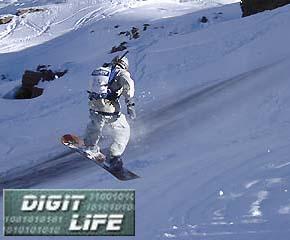 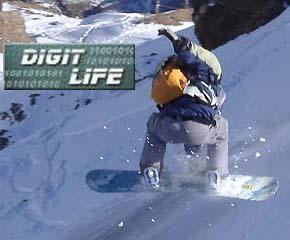 Snowboards' jumps on the Russia Championship. The camera was set for shooting in series of 3 shots. 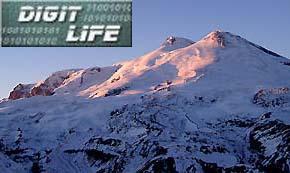 Elbruz - a legend not only in a computer world. On the photo the highest summit of Europe on the sunset from the point of the Russia Championship.  A shot from a helicopter: landing on the start point of the European Cup. "Elbruz - Avia " airline provides delivery of judges, participants and reporters to the place of competition. You can see there that another harmful factor is a snow icy spray created by helicopter's propellers. 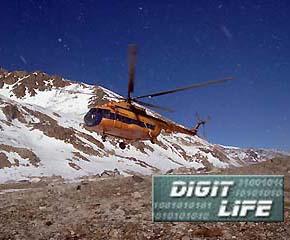 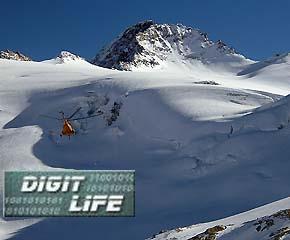 The freeride competition is so hard-to-reach region for lookers that nearly all information on competitions they receive from the press.  A panorama shot from the finish point of the European Cup (3100 m) is almost round, but we decided not to shoot right against the sun. Clear air, bright sun and snow gives us a picture with a mad dynamic range between the light and shadow. In order to take this shot I had to use a polarization filter. Polarization filters when shooting nature with a digital camera is a topic for another article I'm planning to write. 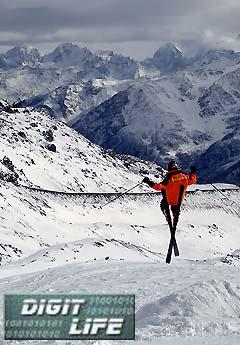 Training sometimes gives more striking shots than competitions: several episodes of training process. 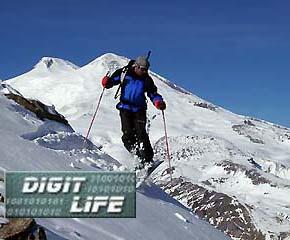 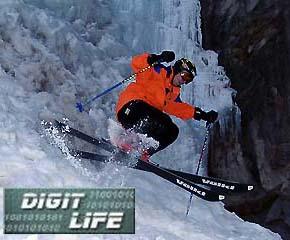 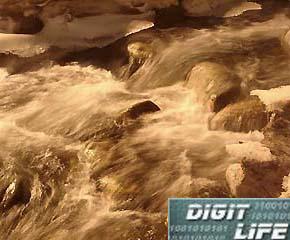 Shooting of water is one of the topics for the next review, and now you can see a photo of Baksan streams which is made in sepia colors. I managed to shoot with long exposure having put sun glasses on the lens. Click on the photo to enlarge it, but you will get only an image 30% of the original. If you want to estimate the max possible quality of this camera note that the frames size is 2048 X 1536 pixels, and the full panorama's size is 12804 X 1855 pixels, when clicking you will get a reduced variant 2761 X 400 pixels in size. We plan to test digital equipment further in real
conditions and we are ready for collaboration with interested persons
and organizations.
Write a comment below. No registration needed!
|
Platform · Video · Multimedia · Mobile · Other || About us & Privacy policy · Twitter · Facebook Copyright © Byrds Research & Publishing, Ltd., 1997–2011. All rights reserved. | |||||||||||||||||||||||||||||||||||||||||||||||||||||||